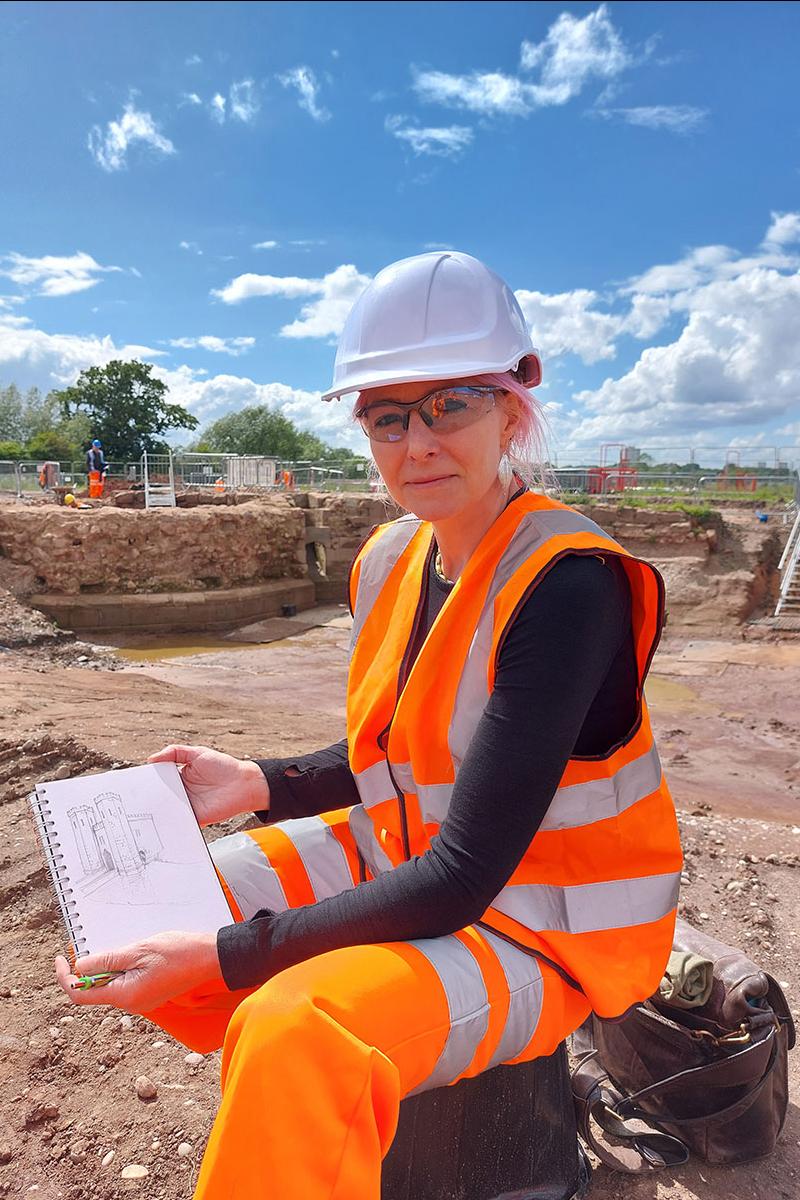Excavations on behalf of LM for HS2 at Coleshill in Warwickshire continue to provide tantalising evidence of the magnificent Coleshill Manor and its tumultuous history. Thought to have been constructed in the 14th century, the presence of the heavily fortified gatehouse was not expected, having only been recorded as a passing mention in 17th-century records.
Yet, what surprised archaeologists most was the striking evidence that the gatehouse had come under attack. With approximately 200 impact marks made by pistol and musket shot to the outside of the gatehouse and the remains of over 40 used shots uncovered in what would have been the moat, it was clear the gatehouse had come under fire.
These findings are featuring on Digging for Britain on BBC2 on Sunday 22nd January 2023 at 8pm, also available on BBC iPlayer.


Above left: Professor Alice Roberts on site at HS2 Coleshill, filming for Digging for Britain.
Above right: Musket ball impact marks on the outside wall of Coleshill gatehouse
Professor Alice Roberts, historian and presenter of Digging for Britain, said: “The discovery of the medieval gatehouse at Coleshill was quite unexpected - and I was amazed at just how much of the monumental stone building, with its two great octagonal towers, had survived below the ground. The front of the gatehouse was pockmarked and had clearly been shot at with muskets - perhaps for target practice - but there’s also an intriguing possibility that we’re looking at evidence of the earliest skirmish of the Civil War."
The manor came into the hands of Royalist Simon Digby in the late 15th century following the execution of the manor’s previous owner, Simon de Montford. De Montford was hung, drawn and quartered for treason in 1494, upon which his estate was transferred to Digby. But by the 17th century, the political mood had worsened and Civil War was approaching.

Above: Remains of Coleshill gatehouse towers during excavation for HS2
The first recorded battle of the Civil War, the Battle of Curdworth Bridge, took place in 1642 only a short distance from Coleshill manor. The Roundheads (parliamentarians) would have passed close by the manor on their way to the battle. Located next to a bridge over the River Cole, the manor commanded a strategic position that the Roundheads would have undoubtedly wanted to control. Did they stop at Coleshill manor on their way to the battle? If so, was this one of the first skirmishes of the Civil War? The historical records of the Civil War are confined to famous battles, so we will never know. Yet the evidence at Coleshill may provide a rare glimpse into the impact of war on the lives of those not recorded in the history books.
Stuart Pierson, Archaeologist, Wessex Archaeology, said: “As the excavations at Coleshill for HS2 wrap up, it’s timely to reflect on the extraordinary archaeology we have discovered and recorded.
Although we knew there was a manor house at the site, we had no idea that we would uncover such rich and revealing archaeological evidence. From one of the most impressive Elizabethan ornamental gardens in the country to the remains of what could be the first skirmish of the Civil War, these findings - not recorded in historical records - would have been lost to time, had it not been for the expertise and hard work of the team.”
The gatehouse went out of use in the 1650s and was demolished making way for a newer modern manor, courtyard and gardens. Our archaeologists have recently finished excavation at Colehill but will continue to uncover the hidden histories of the manor and its inhabitants as our research continues.
Learn more about our excavation of the gatehouse in this short HS2 film or join us for a free HS2 webinar exploring the archaeology of Coleshill Manor and its tumultuous history. Watch this space for dates!

